Papers by Dr. M . Gokilavani

Reinforcement Learning (RL) is a branch of machine learning that focuses on how agents can lear... more Reinforcement Learning (RL) is a branch of machine learning that focuses on how agents can learn to make decisions through trial and error to maximize cumulative rewards. RL allows machines to learn by interacting with an environment and receiving feedback based on their actions. This feedback comes in the form of rewards or penalties. Reinforcement Learning revolves around the idea that an agent (the learner or decision-maker) interacts with an environment to achieve a goal. The agent performs actions and receives feedback to optimize its decision-making over time. o Agent: The decision-maker that performs actions. o Environment: The world or system in which the agent operates. o State: The situation or condition the agent is currently in. o Action: The possible moves or decisions the agent can make. o Reward: The feedback or result from the environment based on the agent's action. The RL process involves an agent performing actions in an environment, receiving rewards or penalties based on those actions, and adjusting its behavior accordingly. This loop helps the agent improve its decision-making over time to maximize the cumulative reward. o Policy: A strategy that the agent uses to determine the next action based on the current state. o Reward Function: A function that provides feedback on the actions taken, guiding the agent towards its goal. o Value Function: Estimates the future cumulative rewards the agent will receive from a given state. o Model of the Environment: A representation of the environment that predicts future states and rewards, aiding in planning. 1. Q-Learning: A model-free algorithm where the agent learns a value function Q(s,a), which represents the expected utility of taking action a in state s and following the optimal policy thereafter. 2. SARSA (State-Action-Reward-State-Action): Similar to Q-Learning, but updates the Qvalue based on the action actually taken, considering the policy followed by the agent. Positive Reinforcement Negative Reinforcement 1. Positive Reinforcement Positive Reinforcement is defined as when an event, occurs due to a particular behavior, increases the strength and the frequency of the behavior. In other words, it has a positive effect on behavior. Advantages: Maximizes performance, helps sustain change over time. Disadvantages: Overuse can lead to excess states that may reduce effectiveness. Negative Reinforcement is defined as strengthening of behavior because a negative condition is stopped or avoided. Advantages: Increases behavior frequency ensures a minimum performance standard. Disadvantages: It may only encourage just enough action to avoid penalties. In reinforcement learning, a common example of an agent getting "lost" is when it fails to learn an effective policy or strategy to reach its goal in a given environment. This can happen due to factors like insufficient exploration, difficulty in generalizing to new situations, or problems with credit assignment.

Learning refers to the process where algorithms, models, or systems adapt and improve their per... more Learning refers to the process where algorithms, models, or systems adapt and improve their performance based on data input and experience. "Tree" refers to a decision tree; a supervised learning algorithm used for both classification and regression tasks. It's a flowchart-like structure where each node represents a test on an attribute, each branch represents the outcome of the test, and each leaf node represents a class label or a predicted value. Tree-based algorithms are a fundamental component of machine learning, offering intuitive decision-making processes to human reasoning. These algorithms construct decision trees, where each branch represents a decision based on features, ultimately leading to a prediction or classification. By recursively partitioning the feature space, tree-based algorithms provide transparent and interpretable models, making them widely utilized in various applications. Tree-based algorithms are a class of supervised machine learning models that construct decision trees to typically partition the feature space into regions, enabling a hierarchical representation of complex relationships between input variables and output labels. Some of tree based algorithm are i. Random forests ii. Gradient Boosting techniques iii. Decision trees iv. Gini impurity v. Information gain The main four workflows of tree-based algorithms are discussed below: 1. Feature Splitting: Tree-based algorithms begin by selecting more informative features to split a data set based on a specific criterion, such as Gini impurity or information gain etc. 2. Recursive splitting: The selected feature of dataset is used to split the data in two, and the process is repeated for each resulting subset, forming a hierarchical binary tree structure. This recursive splitting until stops a predefined criterion, like a maximum depth or a minimum number of samples per train data, is met as long as it lasts. 3. Leaf Node Function: As the tree grows, each terminal node (leaf) is given a predicted outcome based on majority learning (for classification) or the sample value of that node of the (for regression). This activates the tree to capture complex decision boundaries and relationships in the data. For ensemble methods like Random Forests and Gradient Boosting Machines, multiple trees are trained independently, and their predictions are combined to obtain the final result. This group approach helps to reduce over fitting, increase generalization, and improve overall model performance by combining the strengths of individual trees and reducing their weaknesses. Decision Tree is a supervised learning technique that can be used for both classification and Regression problems, but mostly it is preferred for solving Classification problems. It is a tree-structured classifier, where internal nodes represent the features of a dataset, branches represent the decision rules and each leaf node represents the outcome. A decision tree can contain categorical data (YES/NO) as well as numeric data. Decision tree is graphical representation for getting all the possible solutions to a problem/decision based on given conditions. There are two nodes, which are the Decision Node and Leaf Node. Decision nodes are used to make any decision and have multiple branches. Leaf nodes are the output of those decisions and do not contain any further branches.
Computer Organization and Architecture
Microelectronics Journal, 2000
Page 1. CHAPTER 2.B. MJ Flynn Stanford University Stanford, Ca., USA C!)mputer Organization and A... more Page 1. CHAPTER 2.B. MJ Flynn Stanford University Stanford, Ca., USA C!)mputer Organization and Architecture Page 2. 18 COMPUTER ORGANIZATION AND ARCHITECTURE* MJ Flynn Department of Electrical Engineering ...
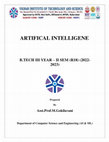
Prerequisites: 1. A course on "Computer Programming and Data Structures" 2. A course on "Advanced... more Prerequisites: 1. A course on "Computer Programming and Data Structures" 2. A course on "Advanced Data Structures" 3. A course on "Design and Analysis of Algorithms" 4. A course on "Mathematical Foundations of Computer Science" 5. Some background in linear algebra, data structures and algorithms, and probability will all be helpful Course Objectives: To learn the distinction between optimal reasoning Vs. human like reasoning To understand the concepts of state space representation, exhaustive search, heuristic search together with the time and space complexities. To learn different knowledge representation techniques. To understand the applications of AI, namely game playing, theorem proving, and machine learning. Course Outcomes: Ability to formulate an efficient problem space for a problem expressed in natural language. Select a search algorithm for a problem and estimate its time and space complexities. Possess the skill for representing knowledge using the appropriate technique for a given problem. Possess the ability to apply AI techniques to solve problems of game playing, and machine learning.
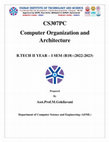
unit. The purpose of the communication link is to resolve the differences that exist between th... more unit. The purpose of the communication link is to resolve the differences that exist between the central computer and each peripheral. The major differences are: 1. Peripherals are electromechanical and electromagnetic devices and their manner of operation is different from the operation of the CPU and memory, which are electronic devices. Therefore, a conversion of signal values may be required. 2. The data transfer rate of peripherals is usually slower than the transfer rate of the CPU, and consequently, a synchronization mechanism may be need. 3. Data codes and formats in peripherals differ from the word format in the CPU and memory. 4. The operating modes of peripherals are different from each other and each must be controlled so as not to disturb the operation of other peripherals connected to the CPU. To resolve these differences, computer systems include special hardware components between the CPU and peripherals to supervise and synchronize all input and output transfers. These components are called interface units because they interface between the processor bus and the peripheral device. In addition, each device may have its own controller that supervises the operations of the particular mechanism in the peripheral. i. I/O Bus And Interface Modules: A typical communication link between the processor and several peripherals is shown in Fig. The I/O bus consists of data lines, address lines, and control lines. Each peripheral device has associated with it an interface unit. Each interface decodes the address and control received from the I/O bus, interprets them for the peripheral, and provides signals for the peripheral controller. It also synchronizes the data flow and supervises the transfer between peripheral and processor. Each peripheral has its own controller that operates the particular electromechanical device.
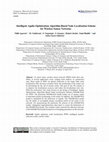
Computers, Materials & Continua
In recent times, wireless sensor network (WSN) finds their suitability in several application are... more In recent times, wireless sensor network (WSN) finds their suitability in several application areas, ranging from military to commercial ones. Since nodes in WSN are placed arbitrarily in the target field, node localization (NL) becomes essential where the positioning of the nodes can be determined by the aid of anchor nodes. The goal of any NL scheme is to improve the localization accuracy and reduce the localization error rate. With this motivation, this study focuses on the design of Intelligent Aquila Optimization Algorithm Based Node Localization Scheme (IAOAB-NLS) for WSN. The presented IAOAB-NLS model makes use of anchor nodes to determine proper positioning of the nodes. In addition, the IAOAB-NLS model is stimulated by the behaviour of Aquila. The IAOAB-NLS model has the ability to accomplish proper coordinate points of the nodes in the network. For guaranteeing the proficient NL process of the IAOAB-NLS model, widespread experimentation takes place to assure the betterment of the IAOAB-NLS model. The resultant values reported the effectual outcome of the IAOAB-NLS model irrespective of changing parameters in the network.
• Register transfer operations: the movement of data stored in registers and the processing perfo... more • Register transfer operations: the movement of data stored in registers and the processing performed on the data. 11/21/2022 Department of CSE (AI/ML) 11 Three-state Gates 11/21/2022 Department of CSE (AI/ML) 20 • A bus system can also be constructed using three-state gates instead of multiplexers. • The three state gates can be considered as a digital circuit that has three gates, two of which are signals equivalent to logic 1 and 0 as in a conventional gate. However, the third gate exhibits a high-impedance state. • The most commonly used three state gates in case of the bus system is a buffer gate. • The graphical symbol of a three-state buffer gate can be represented as:

AI Based Caregiver for Dementia Patients
2021 Fifth International Conference on I-SMAC (IoT in Social, Mobile, Analytics and Cloud) (I-SMAC)
Dementia is a common problem in about 50 millions people around the world. It is increasing day b... more Dementia is a common problem in about 50 millions people around the world. It is increasing day by day with nearly ten million new cases now. India has the second-highest number of affecting population by dementia, at an overall it is estimated that 4.1 million. During the early stages of dementia, the patients will lose memory in doing their daily activities. Dementia commonly starts above the age of 65, but nowadays it’s common in ’40s. The loss of memory, language and communication skill, concentration and analytical ability are some of the main symptoms of the same. Permanent dementia cannot be cured. It can only be controlled by medicine and caregiving. Progress of severity of dementia depends on the caregiving provided but hiring caregivers is expensive. The count of dementia patients in the world is predicted to rise to a level of 131 million by 2050. The AI-Based Care Giver for dementia patients is an Augmented Reality smart glass that acts as an alternate caregiving system that replaces humans. This system establishes the daily routine of the demented patient by learning his/her test routine and predicting the most appropriate output by machine learning. The proposed system is trained to extract a dataset of daily routine as training data by using the neural network for the first 3 months. After training, the virtual caregiver guides the patient throughout the day with his exact daily routine just like a human caregiver. One of our main goals is to ensure the safety of the patient without human supervision. The emergency alert system feature alerts the closest relatives of the patient through a mobile application in case of unusual events.
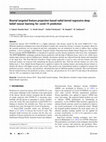
Soft Computing, 2022
Coronavirus disease 2019 (COVID-19) is a highly infectious viral disease caused by the novel SARS... more Coronavirus disease 2019 (COVID-19) is a highly infectious viral disease caused by the novel SARS-CoV-2 virus. Different prediction techniques have been developed to predict the coronavirus disease's existence in patients. However, the accurate prediction was not improved and time consumption was not minimized. In order to address these existing problems, a novel technique called Biserial Targeted Feature Projection-based Radial Kernel Regressive Deep Belief Neural Learning (BTFP-RKRDBNL) is introduced to perform accurate disease prediction with lesser time consumption. The BTFP-RKRDBNL techniques perform disease prediction with the help of different layers such as two visible layers namely input and layer and two hidden layers. Initially, the features and data are collected from the dataset and transmitted to the input layer. The Point Biserial Correlative Target feature projection is used to select relevant features and other irrelevant features are removed with minimizing the disease prediction time. Then the relevant features are sent to the hidden layer 2. Next, Radial Kernel Regression is applied to analyze the training features and testing disease features to identify the disease with higher accuracy and a lesser false positive rate. Experimental analysis is planned to measure the prediction accuracy, sensitivity, and specificity, and prediction time for different numbers of patients. The result illustrates that the method increases the prediction accuracy, sensitivity, and specificity by 10, 6, and 21% and reduces the prediction time by 10% as compared to state-of-the-art works.

Melanoma is one of the most unpredictable and difficult environments to diagnose due to its compl... more Melanoma is one of the most unpredictable and difficult environments to diagnose due to its complexity. It becomes important to identify these diseases at their initial stage to control it from spreading. Traditional approaches for early detection of melanoma by dermatologist to manually measure a skin lesion using the ABCDE (Asymmetry, Border-irregularity, Color variation, Diameter, Evolution) conditions before confirmation can be done through biopsy or pathologist. The main objective of the project is to identify various skin ROI (Region of Interest) at their initial stage whether its melanoma or non-melanoma to treat it very easily. In this project authors proposed an early detection of skin melanoma using Android application and image processing technique by android Studio software and openCV library in Tenser Flow object Detection using API. To evaluate the detection performance, the detection process has been achieved using two different datasets on a real-time mobile applicat...

Ravdness, Crema-D, Tess Based Algorithm for Emotion Recognition Using Speech
2022 4th International Conference on Smart Systems and Inventive Technology (ICSSIT), 2022
Speech is the most important communication among people. While interfacing, the emotions of other... more Speech is the most important communication among people. While interfacing, the emotions of others can be easily comprehended. Nonetheless, this isn't the situation when a human and a machine connect. In this work, machines are made to identify and understand emotions of the human while interacting. The decisions people make are mostly based upon the emotions in many scenarios. The investigations of feeling extraction from human voice are still new and draw in extraordinary consideration. The essential difficulties of feeling acknowledgment are picking the feeling acknowledgment corpora (speech dataset), recognizable proof of various highlights identified with discourse and a suitable decision of an arrangement model. Extracting the required data for emotion extraction poses an important problem, In the modern era of artificial intelligence perception of human emotions the objective of these research paper is to overcome the emotion detection. CNN (Convolution Neural Network) models have been implemented on CREMA-D, RAVDNESS, TESS datasets by adding additional speckel noise to the datasets.

A Survey on Resource Allocation and TaskScheduling Algorithms in Cloud Environment
173 Abstract— Cloud computing is a computing service paradigm that charges under the basis of the... more 173 Abstract— Cloud computing is a computing service paradigm that charges under the basis of the amount of resources consumed i.e. pay per use constraint .One key characteristic that differentiate cloud computing from the other enterprises computing is that the infrastructure itself is programmable. An important issue faced by Infrastructure as a service (IaaS) in task scheduling and resource allocation is a NP-Complete problem. Although, there are various algorithms and methods were existing to solve the problem of resource allocation but none of these algorithms can be extended. The present study involves surveying the different task scheduling and resource allocation algorithms for cloud. Comparing the various algorithms, we conclude that various scheduling algorithms depend on the type of the task to be scheduled.
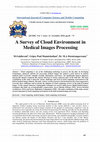
Cloud computing is one of the challenging technology to process the big data. In developing techn... more Cloud computing is one of the challenging technology to process the big data. In developing technologies, advanced software for processing medical images has gained a great interest in modern medicine field. It provides valuable scientific information, and hence, can significantly improve diagnosis and provide advance treatment like tumour detection in various unknown parts of the body like. The main contribution of this study is about the various challenges and need of cloud computing environment in the field of medical images datasets. Recently, various security measures and mechanisms have been suggested to overcome these challenges and accelerate the adoption of cloud computing services in the field of medical images. In this regard, numerous cryptographic techniques are used to safely process digital medical images, techniques that make use of homomorphic cryptosystems, Secret Sharing Schemes (SSS), Service-Oriented Architecture (SOA) and Secure Multi-party Computation (SMC). T...

In recent technologies, advanced software for processing medical images has gained a great intere... more In recent technologies, advanced software for processing medical images has gained a great interest in modern medicine field. It provides valuable scientific information, and hence, can significantly improve diagnosis and provide advance treatment like tumor detection in various unknown parts of the body like. The main contribution of this study is about the various challenges of medical images datasets in MATLAB environment. Recently, various security measures and mechanisms have been suggested to overcome these challenges and accelerate the adoption of various recent services in the field of medical images. Image is the main source of human access and exchange of information. The application of digital image processing in medical engineering is very extensive, and the result is very effective. Medical digital image processing can reduce the effect of noise, enhance the image and improve its quality. Processed images can accurately reflect the focus of disease and visually communic...
Unit 1 Network Hardware session 1
Teaching Documents by Dr. M . Gokilavani
Dr.M.Gokilavani, 2025
GURU NANAK INSTITUTIONS TECHNICAL CAMPUS (AUTONOMOUS) B.Tech. III Year II Sem L T P C 3 0 0 3 22P... more GURU NANAK INSTITUTIONS TECHNICAL CAMPUS (AUTONOMOUS) B.Tech. III Year II Sem L T P C 3 0 0 3 22PCOAM21 DATA ANALYTICS Prerequisites 1. A course on "Database Management Systems". 2. Knowledge of probability and statistics. Course Objectives To explore the fundamental concepts of data analytics. To learn the principles and methods of statistical analysis Discover interesting patterns, analyze supervised and unsupervised models and estimate the accuracy of the algorithms. To understand the various search methods and visualization techniques.











Uploads
Papers by Dr. M . Gokilavani
Teaching Documents by Dr. M . Gokilavani
Spiking Neural Networks-Convolutional Neural Networks-Deep Learning Neural Networks-Extreme Learning Machine Model-Convolutional Neural Networks: The Convolution Operation – Motivation –Pooling – Variants of the basic Convolution Function – Structured Outputs– Data Types – Efficient Convolution Algorithms – Neuroscientific Basis – Applications: Computer Vision, Image Generation, Image Compression.
Training Algorithms for Pattern Association-Autoassociative Memory Network-Heteroassociative Memory Network-Bidirectional Associative Memory (BAM)-Hopfield Networks-Iterative Autoassociative Memory Networks-Temporal Associative Memory Network-Fixed Weight Competitive Nets-Kohonen Self-Organizing Feature Maps-Learning Vector Quantization-Counter propagation Networks-Adaptive Resonance Theory Network.
Department of Artificial Intelligence and Data Science
under anna university
Department of Artificial Intelligence and Data Science
Under Anna University